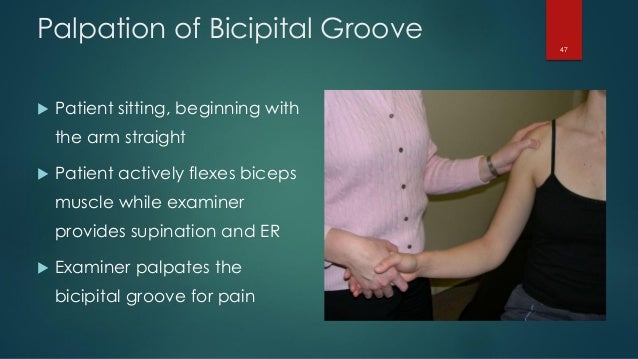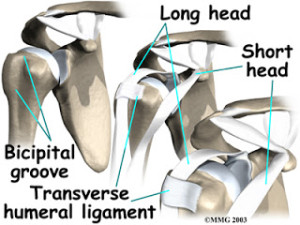Bicipital Groove Test

For the yergason test the elbow is bent at 90 degrees and the forearm is pronated turned and faced down.
Bicipital groove test. If any of these tests is positive it indicates that impingement is present which can lead. This website is powered by sportsengine s sports relationship management srm software but is owned by and subject to the physical therapy haven privacy policy. Pain in the bicipital groove indicating biceps tendinitis subluxation of the long head of the biceps brachii muscle and presence of a slap tear. Biceps tendinitis is an inflammatory process of the long head of the biceps tendon and is a common cause of shoulder pain due to its position and function 2.
Resistance is placed against the forearm as it tries to turn to face up supine position. The test is positive if bicipital groove pain is present. L bis twice caput head. Yergason test is used to test for biceps tendon pathology such as biceps tendinitis bicipital tendonitis and superior labral anterior posterior lesion slap lesion or glenoid labrum tear 1.
Pain at this point may indicate a positive test for sub acromial bursitis. Specificity of the speed s test. It identifies the presence of a pathology involving the biceps tendon or glenoid labrum the specific positive findings to the test include. Here s how to do the yergason s test for slap lesion or biceps pathology which demonstrates as pain in the bicipital groove popping out of the biceps tendon and shoulder instability.
D groeve a groove between the greater and lesser tubercles of the humerus for passage of the tendon of the long head of the biceps muscle. Tenderness on palpation of the bicipital groove also indicates bicipital tendinitis. Palpating the biceps tendon as it passes through the bicipital groove to identify any. Arthroscopic technique for evaluating the biceps tendon at the level of the bicipital groove.
The test is positive if bicipital groove pain is present. For the speed test the patient tries to flex the shoulder against resistance with the elbow extended and the forearm supinated9 20. A positive test is indicative of biceps tendon instability or tendonitis. Speed test the patient tries to flex the shoulder against resistance with the elbow extended and the forearm supinated9 20 figure 5.
This test is used to check the ability of the transverse humeral ligament to hold the biceps tendon in the bicipital groove 1 patient sits while examiner stands in front.


















